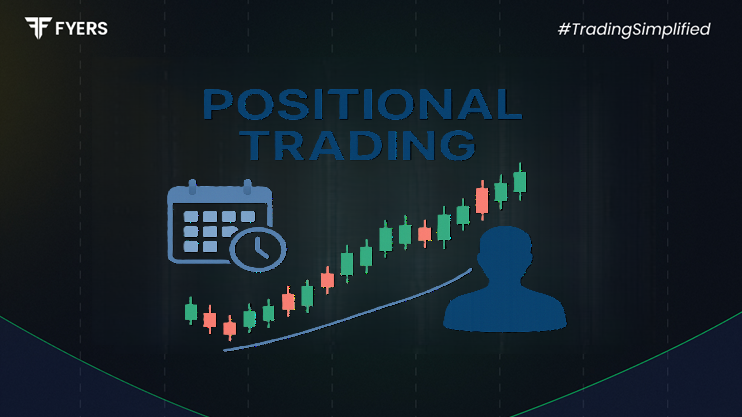

 17 Sep, 2025
17 Sep, 2025
 4 mins read
4 mins read

In the stock market, traders adopt different approaches depending on their goals, risk appetite, and investment horizon. Positional trading is one such style that sits between short-term intraday activity and long-term investing. It allows traders to ride major market trends over days, weeks, or even months while avoiding the noise of daily fluctuations.
This guide explains what positional trading is, how it works, common strategies, benefits, risks, and how it compares to other trading methods.
Positional trading is a strategy where traders hold their positions for an extended period, usually from a few days to several months. Unlike intraday traders, who close their trades before the market shuts, positional traders are willing to wait for broader price movements to play out.
A positional stock is chosen based on strong fundamental outlook or technical signals, with the expectation that the price trend will continue in the desired direction.
In simple words, positional trading is about identifying opportunities with potential for medium- to long-term gains, rather than reacting to intraday volatility.
Positional trading involves analysing both fundamental factors such as earnings reports, economic indicators, and industry performance, as well as technical analysis tools like moving averages, trendlines, and chart patterns.
Key aspects include:
Entry points: Traders look for confirmation of a trend before entering.
Holding period: Positions are maintained until the price target is achieved or the trend reverses.
Exit strategy: Traders set stop-loss levels to minimise risk.
The longer time horizon allows positional traders to filter out market noise, making decisions based on the bigger picture.
In positional trading, traders can take both:
Long trade: Buying a stock with the expectation that its price will rise over time.
Short trade: Selling borrowed shares or using derivatives, anticipating that the stock price will fall, enabling the trader to buy back at a lower price.
Whether long or short, the goal is to capture significant price moves without getting distracted by minor fluctuations.
Some common position trading strategies include:
Trend-following strategy – Riding an established market trend until signs of reversal appear.
Breakout strategy – Entering trades when stock prices break out of resistance or support levels.
Moving average strategy – Using long-term moving averages (e.g., 50-day or 200-day) to identify buy or sell signals.
Fundamental-driven strategy – Choosing positional stocks based on earnings growth, sector outlook, or macroeconomic factors.
These strategies often combine both technical and fundamental research for higher conviction.
Reduced market noise – Traders are less impacted by intraday price swings.
Flexibility – No need to monitor markets constantly.
Potential for higher returns – Long-term trends can provide significant gains.
Leverage of both trades – Traders can capture opportunities with long trade and short trade setups.
Lower transaction costs – Fewer trades mean reduced brokerage and fees compared to intraday strategies.
While beneficial, positional trading carries certain risks:
Market reversals – Long holding periods expose traders to unexpected macroeconomic changes.
Gaps in price – Overnight events may cause sharp movements at market open.
Capital lock-in – Funds remain tied up for longer durations, limiting liquidity.
Emotional discipline – Traders must stick to their strategy without reacting to short-term market noise.
Here’s how positional trading compares with other approaches:
Vs Intraday trading: Intraday relies on daily price swings; positional trading focuses on long-term trends.
Vs Swing trading: Swing trading usually lasts days to weeks, while positional trading may extend for months.
Vs Investing: Investing often spans years with focus on fundamentals, while positional trading blends fundamentals with technicals over a shorter horizon.
This makes positional trading an attractive middle ground between active trading and long-term investing.
Choose positional stocks backed by strong fundamentals.
Use stop-losses to safeguard against unexpected downturns.
Avoid over-leverage when taking an open position in trading.
Track both technical charts and broader market news.
Review trades periodically and adjust targets if market conditions change.
By following these practices, traders can improve their chances of success in positional setups.
Positional trading is a versatile style that allows traders to capture larger price movements while avoiding the stress of daily monitoring. By using effective position trading strategies, understanding both long trade and short trade setups, and managing risks, traders can make the most of this approach.
It stands as a valuable middle path between quick intraday moves and long-term investing, appealing to those who prefer a balanced, trend-driven trading style.
It is a trading style where you hold stocks for days to months, aiming to profit from long-term price trends rather than short-term movements.
Intraday trades are closed within a single day, while positional trades are held for longer periods to ride bigger trends.
A company with strong fundamentals, like consistent earnings growth and industry leadership, could be a good positional stock if technical charts also support the trend.
Yes, traders can take either long or short positions depending on whether they expect the stock price to rise or fall.
Calculate your Net P&L after deducting all the charges like Tax, Brokerage, etc.
Find your required margin.
Calculate the average price you paid for a stock and determine your total cost.
Estimate your investment growth. Calculate potential returns on one-time investments.
Forecast your investment returns. Understand potential growth with regular contributions.